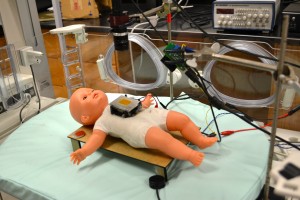 Making Sense
Making Sense
For his master's thesis, Computer Engineering student Kirit Chatterjee worked with scientists from UMBC's Center for Advanced Sensor Technology (CAST) on an innovative temperature sensor for premature babies.
In hospitals, doctors use a thermistor probe to monitor the temperature of a premature baby. But, the glue used to attach it is harmful for the baby, whose skin is as fragile as tissue paper.
“When the probe is removed, there is a high risk of “epidermal stripping” occurring-i.e. the skin of the baby can tear, leaving it open to infection,” explains Kirit Chatterjee, a Computer Engineering graduate student. For his master’s thesis, Kirit helped develop a new temperature sensing device that avoids this problem.
It wasn’t easy. During research, other obvious options had been shot down one by one: Bluetooth sensors had batteries that leaked toxic chemicals. Wireless sensing devices emitted energy that was harmful for the baby.
The solution, supported by an NIH grant, and later commissioned by General Electric (GE), was the result of the combined brain-power of a group of UMBC scientists led by Dr. Govind Rao, Director of UMBC’s Center for Advanced Sensor Technology (CAST). Dr. Yordan Kostov (CAST), Dr. Hung Lam (CAST), and Dr. Ryan Robucci (CSEE)–Kirit’s advisor for the project–were the team’s key players.
Together they created a patch containing a unique fluorescent orange dye. “The intensity of the orange emission depends on the temperature,” explains Dr. Kostov, the senior scientist on the temperature project who also worked closely with Kirit. When the baby’s temperature rises, he explains, the orange patch becomes brighter.
Recording and translating the patch’s fluorescence into a temperature reading that a doctor could understand was Kirit's job. “My part,” explains Kirit, “was to take care of the Engineering side—namely, to build the sensing apparatus.”
Choosing the right camera to monitor the dye was another challenge. The project was bound to a strict budget since the new sensor system was slated for mass production by GE. Therefore, expensive scientific cameras were out of the question.
 Instead, Kirit reverse engineered and manipulated a much more affordable camera to serve his purposes. He used a two megapixel camera–the same camera found inside an iPhone 3–to monitor the dye in the patch.
Instead, Kirit reverse engineered and manipulated a much more affordable camera to serve his purposes. He used a two megapixel camera–the same camera found inside an iPhone 3–to monitor the dye in the patch.
“The dye is just the target for the Computer Engineer,” he says. “To the engineer, it’s just photons being emitted which translate to analog voltage signals inside the camera which then translate to digital bits inside the FPGA and then are analyzed.”
Next, Kirit used an FPGA in order to tap into the camera and retrieve its data, and MATLAB to translate the data into a traditional temperature reading.
The result is a temperature sensing device that is affordable, accurate, and, most importantly, safe for the baby. Dr. Kostov explains that when the GE contract comes to an end this September, the patch system will undergo clinical trials and toxicology tests. If all goes well, the new system should be found in premature baby incubators across the world in as little as two years.
 Making Sense
Making Sense